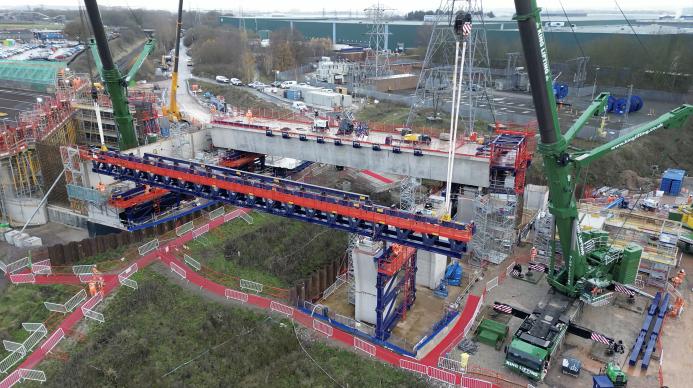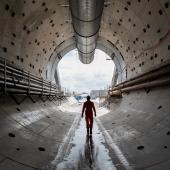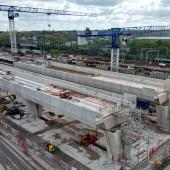Video: First viaduct takes shape at HS2’s ‘linchpin’ Delta Junction
HS2 has completed the first 920-tonne deck span on the first precast segmental viaduct being built at the Delta Junction, signalling a construction milestone as work ramps up on the complex network of 13 viaducts in North Warwickshire.
HS2’s Delta Junction is a triangular section of the line, enabling trains to travel between London and Birmingham, Birmingham and Manchester, and direct between London and Manchester without stopping at Birmingham. It is made up of embankments, cuttings, and a total of 13 viaducts taking high-speed tracks over motorways, local roads, existing rail lines, rivers, and floodplains. The viaducts include six precast segmental viaducts, four composite viaducts and three low viaducts.
The River Tame West Viaduct is a precast segmental viaduct at the northern tip of the Delta Junction, crossing the River Tame near Water Orton, and joins the Curdworth Box which will take high-speed trains over the existing Birmingham to Derby railway.
In this complicated section of the Delta Junction, there are six tracks of the railway running alongside each other as they join the southern end of the Curdworth Box. The River Tame West Viaduct carries three tracks, the River Tame East Viaduct carries one track and the Water Orton Viaducts carry two tracks.
To the south, the 1.4km Water Orton No.1 Viaduct and 1.3km Water Orton No.2 Viaduct curve towards Birmingham allowing trains to travel to and from Curzon Street Station. The other four lines – on the River Tame Viaducts, join on to the HS2 mainline to Interchange Station and on to London.
Construction of the viaduct piers started earlier this year, with deck construction now well underway. The 16 concrete segments for the first span were lifted by crane, placed one-by-one onto two 42m truss beams, moved into place with a skidding trolley, and secured by temporary and then permanent post-tensioning techniques.
The span, weighing 920 tonnes, was then jacked up and the truss was moved onto the adjacent abutment and pier, so the process could start again on the next span.
The three initial spans, all from the same abutment and next to each other, will be constructed using temporary staying masts, swivel cranes, and temporary and permanent post-tensioning techniques.
The project is being delivered by HS2’s main works contractor for the West Midlands, Balfour Beatty VINCI (BBV) who are constructing 90km of HS2 between Long Itchington in Warwickshire to the centre of Birmingham and on to Staffordshire.
A total of 153 piers will be built for the viaducts in the triangle-shaped Delta Junction, with 15 completed already. A total of 2,762 viaduct segments are being made at HS2’s outdoor factory near Lea Marston using a ‘match-casting’ technique. This involves casting each segment against the following segment in a production line, creating a seamless viaduct deck when installed.
Each segment is uniquely precise and adjustable by minimal tolerances. This approach - where each segment is poured against the previous one - ensures the whole geometry fits perfectly when assembled on site.
The layout of the Delta Junction triangle means the railway from London curves west on a spur towards Birmingham Curzon Street Station. As trains come out of Birmingham, the line heads north to meet the main HS2 line, which will then connect to the West Coast Mainline to Manchester. The third side of the triangle allows trains to run between London and Manchester without stopping at Birmingham.
Delta Junction Viaducts:
Six precast segmental viaducts (River Tame East and West; Water Orton 1 and 2; Coleshill East and West). Segmental viaducts have standard spans of 45m with decks built off concrete precast segments which are prefabricated at HS2’s Kingsbury Precast Yard at Lea Marston.
Four composite viaducts (M42/M6 Link Road East and West; River Cole East and West). Composite viaducts have standard spans of more than 45m with their decks built off weathered steel boxes or beams, with a concrete deck on top.
Three low viaducts (M42 Coleshill North and South; Watton House). Low viaducts have standard spans of 25m with their decks built off standard concrete precast beams, with a concrete deck on top.







